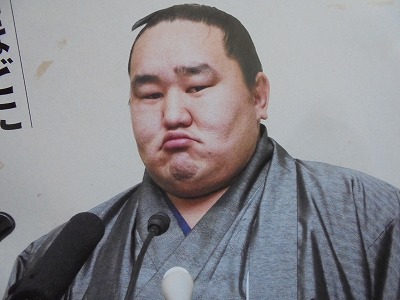If you look at the roof structure over dohyo (round sumo ring), you will find four drapes of different colors hanging down from the ceiling. One drape is set at every direction with a different color. Each direction and its own color have an important meaning. Kanji for each direction and its own color is often used as part of shikona. For your better understanding, the roof structure over dohyo had been supported by four big pillars near seats in the audience, but those pillars were removed and replaced with a ceiling suspension system in 1952 for making the view from the audience clearer. So, the removal was well-reputed by the sumo fans in those days.
“青”
Meaning:Blue
How to Read : Ao・Shou
This kanji stands for blue. It is the color of the drape in the northeast hanging down from the ceiling over dohyo. The blue is the symbol of the Blue Dragon dedicated as a divine animal. The Blue Dragon protects the east and the spring. A representative rikishi using this kanji as part of shikona is “朝青龍” (Asa-Shou-Ryu).
“赤”
Meaning:Red
How to Read : Seki
This kanji stands for red. It is the color of the drape in the southeast hanging down from the ceiling over dohyo. The red is the symbol of Red Phoenix named Suzaku, a legendary Chinese bird, dedicated as a divine animal. The Red Phoenix protects the south and the summer. This kanji is very rarely used as part of shikona. One of the fewest rikishi using this kanji is “朝赤龍” (Asa-Seki-Ryu), a Mongolian rikishi who flourishes now. Interestingly, this kanji as in “朝赤龍” reads “Seki ” even though this kanji usually reads “Aka” (meaning red). Asasekiryu is one of the fellow disciples of Asashouryu in the same school (Takasago stable) and named so in contrast to Asashouryu.
“白”
Meaning:White
How to Read : Haku・Shiro・Shira
This kanji stands for white. It is the color of the drape in the southwest hanging down from the ceiling over dohyo. The white is the symbol of White Tiger dedicated as a divine animal. The White Tiger protects the west and the autumn. This kanji is representatively used as part of the shikona of “白鵬” (Haku-Hou).
“黒”
Meaning:Black
How to Read : Kuro・Guro・Koku・Kok
This kanji stands for black. It is the color of the drape in the northwest hanging down from the ceiling over dohyo. The black is the symbol of Black Warrior called Genbu, a legendary long-legged turtle around which a snake tightly winds, dedicated as a divine animal. The Black Warrior protects the north and the winter. This kanji, as part of shikona, reminds us of a famous and strong rikishi whose shikona was “羽黒山” (Ha-Guro-Yama). He was ranked as Yokozuna over 11 years from 1942. He was named Haguroyama after his hometown.
“東”
Meaning:East
How to Read : Azuma・Tou
The east of dohyo is decorated by the blue-colored drape hanging down from the ceiling, standing for the spring. The Blue Dragon is dedicated as a divine animal in the east. “東” as part of shikona often means “東京” (Tokyo), the capital of Japan. This kanji is often used as part of rikishi who were born and brought up in Tokyo. For your better understanding, when this kanji reads Azuma, this kanji means Tokyo. On the other hand, when this kanji reads Higashi, it means the direction of east. There has been no rikishi whose shikona using this kanji reads Higashi.
“南”
Meaning:South
How to Read : Minami・Nan
The south of dohyo is decorated by the red-colored drape hanging down from the ceiling. The red drape stands for the summer, and the Red Phoenix named Suzaku is dedicated as a divine animal in the south. This kanji is often used for rikishi who are originally from the southern areas, especially for rikishi from Samoa and Tonga.
“西”
Meaning:West
How to Read : Nishi
The west of dohyo is decorated by the white-colored drape hanging down from the ceiling. The white drape stands for the autumn, and the White Tiger is dedicated as a divine animal in the west. This kanji is very rarely used as part of shikona. The one and only example is “西ノ海” (Nishi-No-Umi ) who became Yokozuna in 1890. This shikona was handed down to the 2nd and 3rd generation of rikishi, and both of them also became Yokozuna.
“北”
Meaning:North
How to Read : Kita・Hoku
The north of dohyo is decorated by the black-colored drape hanging down from the ceiling. The black drape stands for the winter, and the Black Warrior named Genbu is dedicated as a divine animal in the north. This kanji is often used for rikishi who are originally from northern areas. Formerly many of rikishi originally came from northern parts of Japan and they used this kanji as part of their shikona, while nowadays the number of rikishi from northern parts of Japan has become less than before. Currently rikishi who use this kanji as part of their shikona have been just traditionally given this kanji by their trainers (Oyakata) who are originally from northern parts of Japan.


